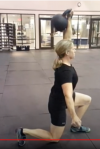Brian H
Level 2 Valued Member
Hi all,
I'm doing S+S and and am in the middle of progressing from 24kg to 32kg in the TGUs. Following the program in the revised edition, I do the 32kg lift on the 3rd and 4th TGU out of 10. I started doing it on the 5th and 6th TGU as well, but began experiencing this issue so I've dialed it back some:
As I continue to train S+S 5 or 6 times a week, I'm noticing increasing pain in my right knee most seemingly brought on when it's in the back of the split squat position (bell in left hand, left knee up, right knee on floor). When I stand from that position, I notice some pain and weakness in the right knee that gets worse and I continue day after day. I can do the 24kg TGUs no problem and the 32kg TGUs are not an issue for a while, but as I continue to do more and more with the 32, the knee feels like it's wearing down when in that particular position. I have seen a PT and have no known injuries to the area.
This has me wondering if perhaps it's a form issue. My best guess is that maybe I'm recruiting my back leg to do too much work in the lift once I move up to 32kg. I'm wondering how you all think about what the appropriate division of labor is between the front (raised-knee) leg and the back (grounded-knee) leg when moving from the split squat position to bell to standing with bell overhead. Should I really be focusing on generating most of my power in the front leg, or is it proper to recruit the back leg for a fair amount of it? And I'm wondering what your setup is to achieve the most power from the appropriate source to achieve that motion. I've played around with both a close-together stance and a stance with more of my bodyweight over the front leg and the back leg trailing further back, but I haven't noticed much of a difference.
Thanks so much for reading and for any thoughts you all might have. I've found this forum to be a tremendous resource as I've gotten more into kettlebell training, but this is my first post here.
I'm doing S+S and and am in the middle of progressing from 24kg to 32kg in the TGUs. Following the program in the revised edition, I do the 32kg lift on the 3rd and 4th TGU out of 10. I started doing it on the 5th and 6th TGU as well, but began experiencing this issue so I've dialed it back some:
As I continue to train S+S 5 or 6 times a week, I'm noticing increasing pain in my right knee most seemingly brought on when it's in the back of the split squat position (bell in left hand, left knee up, right knee on floor). When I stand from that position, I notice some pain and weakness in the right knee that gets worse and I continue day after day. I can do the 24kg TGUs no problem and the 32kg TGUs are not an issue for a while, but as I continue to do more and more with the 32, the knee feels like it's wearing down when in that particular position. I have seen a PT and have no known injuries to the area.
This has me wondering if perhaps it's a form issue. My best guess is that maybe I'm recruiting my back leg to do too much work in the lift once I move up to 32kg. I'm wondering how you all think about what the appropriate division of labor is between the front (raised-knee) leg and the back (grounded-knee) leg when moving from the split squat position to bell to standing with bell overhead. Should I really be focusing on generating most of my power in the front leg, or is it proper to recruit the back leg for a fair amount of it? And I'm wondering what your setup is to achieve the most power from the appropriate source to achieve that motion. I've played around with both a close-together stance and a stance with more of my bodyweight over the front leg and the back leg trailing further back, but I haven't noticed much of a difference.
Thanks so much for reading and for any thoughts you all might have. I've found this forum to be a tremendous resource as I've gotten more into kettlebell training, but this is my first post here.

